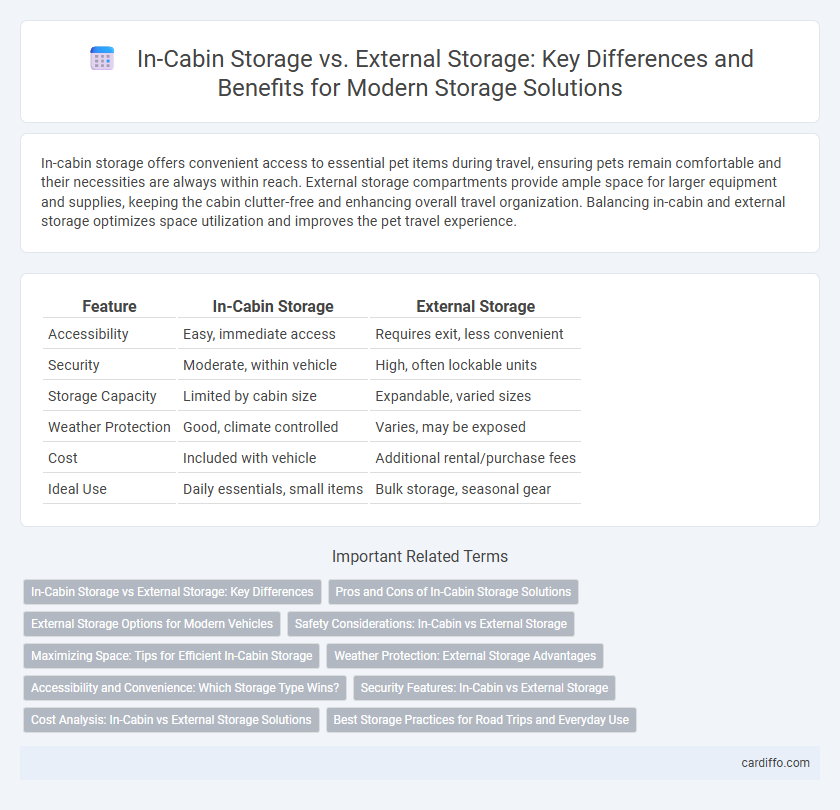In-cabin storage offers convenient access to essential pet items during travel, ensuring pets remain comfortable and their necessities are always within reach. External storage compartments provide ample space for larger equipment and supplies, keeping the cabin clutter-free and enhancing overall travel organization. Balancing in-cabin and external storage optimizes space utilization and improves the pet travel experience.
Table of Comparison
| Feature | In-Cabin Storage | External Storage |
|---|---|---|
| Accessibility | Easy, immediate access | Requires exit, less convenient |
| Security | Moderate, within vehicle | High, often lockable units |
| Storage Capacity | Limited by cabin size | Expandable, varied sizes |
| Weather Protection | Good, climate controlled | Varies, may be exposed |
| Cost | Included with vehicle | Additional rental/purchase fees |
| Ideal Use | Daily essentials, small items | Bulk storage, seasonal gear |
In-Cabin Storage vs External Storage: Key Differences
In-cabin storage offers immediate accessibility and enhanced security for personal items, leveraging compartments integrated within the vehicle's interior. External storage provides increased capacity and versatility, often utilizing roof racks, cargo trailers, or hitch-mounted carriers tailored for larger or bulkier goods. Choosing between in-cabin storage and external storage depends on factors such as convenience, space requirements, vehicle design, and travel duration, optimizing overall storage efficiency.
Pros and Cons of In-Cabin Storage Solutions
In-cabin storage solutions offer easy access and convenience, allowing drivers to keep essential items within reach while on the road. These storage options often maximize space efficiency without increasing vehicle size, though they can limit cargo capacity compared to external storage units. However, in-cabin storage may reduce passenger comfort and can pose safety concerns if not properly secured during sudden stops.
External Storage Options for Modern Vehicles
Modern vehicles offer a variety of external storage options designed to increase cargo capacity without compromising cabin space. Roof racks, cargo boxes, and hitch-mounted carriers provide versatile solutions for transporting bulky items such as sports equipment, luggage, and camping gear. These external storage systems enhance vehicle functionality by expanding load capacity while maintaining passenger comfort and safety inside the cabin.
Safety Considerations: In-Cabin vs External Storage
In-cabin storage enhances safety by allowing immediate access to essential items and reducing distractions while driving. External storage, such as roof racks or rear-mounted containers, can affect vehicle stability and aerodynamics, increasing the risk of accidents if improperly secured. Proper weight distribution and secure fastening are critical for maintaining vehicle control and reducing hazards in both storage methods.
Maximizing Space: Tips for Efficient In-Cabin Storage
Maximizing in-cabin storage involves utilizing vertical spaces with stackable organizers and under-seat compartments to keep essential items accessible without cluttering the cabin. External storage solutions such as roof racks or hitch-mounted carriers provide additional capacity for bulky gear, freeing up interior space for passengers and smaller belongings. Combining both storage types strategically ensures optimal space efficiency and enhances overall comfort during travel.
Weather Protection: External Storage Advantages
External storage offers superior weather protection by utilizing weather-resistant materials and sealed enclosures to safeguard contents from rain, snow, and UV exposure. In-cabin storage is vulnerable to temperature fluctuations and moisture ingress, potentially damaging sensitive items. Outdoor units often feature advanced drainage and ventilation systems that reduce condensation and prevent mold growth, ensuring long-term preservation of stored goods.
Accessibility and Convenience: Which Storage Type Wins?
In-cabin storage offers superior accessibility and convenience by keeping items within arm's reach and reducing the time spent retrieving essentials during travel. External storage enhances cargo capacity but often sacrifices quick access, requiring stops to unlock and organize compartments. For frequent item retrieval and seamless access, in-cabin storage outperforms external storage in everyday usability.
Security Features: In-Cabin vs External Storage
In-cabin storage offers enhanced security features by keeping valuables within the vehicle's locked interior, reducing the risk of theft and exposure to weather elements. External storage compartments often incorporate reinforced locking mechanisms and tamper-resistant designs to protect against forced entry and environmental damage. Choosing between in-cabin and external storage depends on balancing accessibility needs with the level of security required for sensitive or valuable items.
Cost Analysis: In-Cabin vs External Storage Solutions
In-cabin storage solutions often involve higher initial costs due to design complexity and integration requirements but offer enhanced accessibility and security for frequently used items. External storage systems typically present lower upfront expenses and increased capacity, yet may incur additional costs related to weatherproofing, maintenance, and security measures. Evaluating total cost of ownership requires considering factors such as installation, durability, convenience, and potential impact on operational efficiency.
Best Storage Practices for Road Trips and Everyday Use
In-cabin storage offers quick access to essentials like snacks, maps, and electronics, making it ideal for road trips where convenience and safety are priorities. External storage, such as roof racks or cargo boxes, provides ample space for bulky items like camping gear and luggage, freeing up interior comfort for passengers. Combining both storage types ensures efficient organization, maximizes space, and enhances the overall travel experience during long journeys and everyday commutes.
in-cabin storage vs external storage Infographic

 cardiffo.com
cardiffo.com